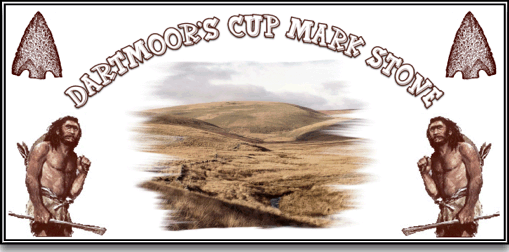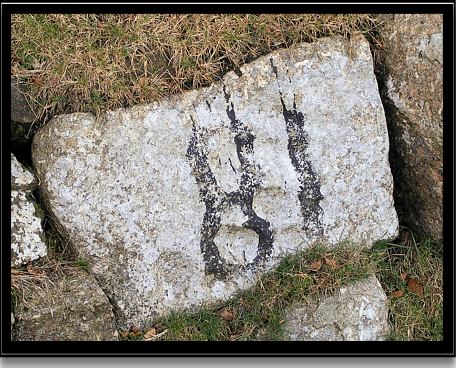
‘Rock Art’ seems to be a popular subject in certain archaeological circles with new discoveries being made all the time. Cave paintings have been discovered at Cresswell Crags and Cheddar which previously were said not to be exist in the UK. Under the ‘umbrella’ of rock art comes the ‘cup and ring’ marked stones which are normally regarded as a phenomenon associated with northern Britain, especially Northumbria. At one time it was thought that the phenomenon of rock art dated to the Early Bronze Age which would have given it a date of between 2,000 – 1,500 BC ago. But a recent archaeological excavation at Hunterheugh Crags has revealed that “cup and ring carving appears to have a long currency stretching from the Early Neolithic at one end through to the Early Bronze Age at the other,” Waddington, 2004, p21.
So what has a predominantly Northern phenomenon got to do with Dartmoor? Basically, there are a three examples of cup marked stones on the moor. The best and most accessible stone can be found built into the wall that runs alongside the track which leads up to Omen Beam. Clearly this stone is completely out of context and its origin is unknown but none the less there are 14 ‘cups’ on the face. Without dismantling the wall it is impossible to say if there are any further marks on the hidden faces. But the appearance of the rock does suggest that it has at some time been dressed so it is impossible to estimate its natural size and shape. The picture below shows the stone ‘in situ’.

You can see that some ‘modern’ rock art has been added in the shape of what looks to be the figure ’18’. I say ’18’ because at the top of the stone the paint has ran/dripped down which suggests that it is upside down in the wall. Nobody knows the significance of the paint daubing, perhaps it was done to ease identification or maybe it was used as a modern boundary marker. The OS map of 1889/91 shows that neither the wall or the plantation were in existence at that time so it can be assumed it was built at a later date. The actual purpose of cup marked stones is unknown and there have been many suggestions as to what they were signified. Butler, 1999, p.64 list some of the more popular theories as: “places for initiation rites, territory markers, star maps, maps, aids for copper prospecting, musical instruments, platforms for excarnation, boundary markers, graffiti, religious symbols, decorations, and some kind of ‘language’. Parker Pearson, 2005, p.68, considers that cup and ring marks were originally “a pan-European style, found from central Europe to Scandinavia to Iberia.” It is thought that the marks were made by pecking out a depression in the rock and then grinding them into the required semi-spherical shapes. Sadly at the moment there is very little information or work done on the cup marked stones of Dartmoor, there are probably other examples just waiting to be found some where on the moor. But the very fact that there are examples on Dartmoor indicates that there was certainly some kind of interaction and exchange of ideas occurring between the prehistoric moorland dwellers and people from further away, possibly even Northumbria. It is slightly ironic to think that if the cup marked stones were originally used as boundary markers this one is once again marking a boundary possibly that of Dartmoor Prison Land.
The University of Newcastle Upon Tyne have an excellent website which archives many examples of rock art that has been found in Northumbria:
Back in 1984 an English Heritage Field Investigator categorically stated that this stone was infact a much later Mortar Stone; “This granite block, built into the stone wall which forms the eastern boundary of Long Plantation, appears to be a mortar stone, not a prehistoric cup marked stone. The granite block measures 0.7m wide by 0.5m high; its thickness cannot be measured. There are approximately 12 circular depressions on its eastern face. These measure between 0.075 and 0.1m in diameter and up to 0.05m in depth. There are two rows of three depressions; the others are arranged at random. The mortar stone itself appears to be part of a relatively recent wall repair and is upside down to its previous position. Its original location is unknown. The figure 18 is painted on its eastern face, suggesting a previous use by the military or the prison authorities.” However, previous to that T.A.P. Greeves wrote in 1980 that; “A possible cup-marked stone lies by the road on the eastern side. It is of undressed granite with 14 cup shaped hollows in it of varying degrees of distinctness. Dimensions of stone circa 0.8 meters by 0.53 meters, dimensions of hollows from 3.0 – 12.0 centimetres in diameter, and 2.5 – 4.0 centimetres deep. More likely of prehistoric origin than a mortarstone.” – Greeves, T. A. P., 1980, Cup-marked stone (Worksheet). SDV278144. So basically ‘you pays your money and takes your choice’ – prehistoric or historic?
Bibliography.
Butter, R. 1999 Kilmartin, The Kilmartin Trust, Kilmartin.
Parker Pearson, M. 2005 Bronze Age Britain, Batsford, London.
Waddington, C. 2004 Rock of Ages, British Archaeology (Sept. 2004), C.B.A.
 Legendary Dartmoor The many aspects past and present of Dartmoor
Legendary Dartmoor The many aspects past and present of Dartmoor

On a field trip heading for the quarry I came across a small standing stone just north of the tor, on its north face it had numerous cup marks about 10cm across. Unluckily I had used up my camera film and I have not been back since.
SX758771 erect cup marked stone 3′ x 2′ numerous cups on N face, between Haytor Rocks & Haytor Quarry, seen April 1995 but no film left.
i suspect they have a link with the strange looking cup shaped coins found in brandenburg germany these gold cup shaped coins are said to have been buried where a rainbow seems to touch the ground according bto some celtic beliefs of course rainbows dont touch the ground i suspect but these cup shaped god coins resemble the cup marks found on standing stoned and the like i suspect it will be some tzime before we get to understand what they were for